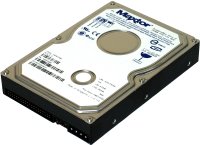
 drives come in two form factors - 3.5" drives and 2.5" drives. The larger drives are used almost exclusively in desktop PCs of the type found in homes and offices, while the smaller 2.5" drives are found in laptop computers. The pictures above show a 3.5" HDD (left) alongside the smaller and
drives come in two form factors - 3.5" drives and 2.5" drives. The larger drives are used almost exclusively in desktop PCs of the type found in homes and offices, while the smaller 2.5" drives are found in laptop computers. The pictures above show a 3.5" HDD (left) alongside the smaller and  thinner 2.5" HDD. In a desktop PC the HDD is normally mounted in an enclosure at the bottom of the system case and will be connected to the motherboard by means of a
thinner 2.5" HDD. In a desktop PC the HDD is normally mounted in an enclosure at the bottom of the system case and will be connected to the motherboard by means of a  ribbon cable similar to the one in the diagram. Also connected to the HDD will be a 12V Molex power connector from the system power supply unit. A closer look inside the HDD case will reveal why a 12V power supply is needed.
ribbon cable similar to the one in the diagram. Also connected to the HDD will be a 12V Molex power connector from the system power supply unit. A closer look inside the HDD case will reveal why a 12V power supply is needed.Inside the case, which you should never attempt to open, is a stack of circular platters. These are made either of aluminium alloy or a mixture of glass and ceramic. To allow data storage, both sides of each platter are coated with a magnetic medium - formerly magnetic oxide, but now, almost exclusively, a layer of metal called a thin-film medium. This stores data in magnetic patterns, with each platter capable of storing a billion or so bits of data per square inch (bpsi) of platter surface. Typically two or three or more platters are stacked on top of each other with a common
 spindle that turns the whole assembly at several thousand revolutions per minute. There's a gap between the platters, making room for magnetic read/write heads, mounted on the end of an actuator arm. The designation 3.5" and 2.5" refers to the diameter of the platters. The 12V power supply is needed to turn the spindle at speeds up to 10,000 rpm, but more commonly 7,200 rpm.
spindle that turns the whole assembly at several thousand revolutions per minute. There's a gap between the platters, making room for magnetic read/write heads, mounted on the end of an actuator arm. The designation 3.5" and 2.5" refers to the diameter of the platters. The 12V power supply is needed to turn the spindle at speeds up to 10,000 rpm, but more commonly 7,200 rpm.Because the HDD has platters rotating at such high speeds and a read-write head zooming around just above the surface of the platters, it is easy to damage a HDD if the PC is moved or jolted suddenly while the platters are spinning.
As we said at the beginning, the HDD is the long term memory of the PC where programs, data and indeed the operating system itself are stored as magnetically-oriented metal particles on the surface of the platters. This data is persistent and, unlike the data in RAM, does not disappear when power to the PC is turned off. The amount of data that can be stored on a single HDD has grown dramatically over the past few years. Five years ago a 40GB hard disc drive was considered large. Today, the largest capacity HDDs are in the region of 500GB and most new PCs will have 160GB-250GB HDDs as standard - an awesome amount of storage capacity for a domestic PC.
Tomorrow, plug-in cards.
No comments:
Post a Comment